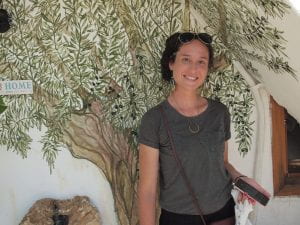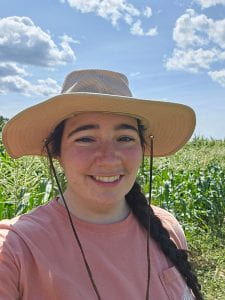From vitamin content in peppers to copper uptake by grasses to disease resistance in rice – these are just a few of the diverse graduate student projects recently funded through the Schmittau-Novak Small Grants Program. Supported by a bequest from the estate of Jean Schmittau in honor of Joseph Novak, Plant Biology Professor Emeritus, the Schmittau-Novak Small Grants Program is designed to provide graduate students in the School of Integrative Plant Science with the opportunity to experience the process of writing and reviewing proposals, and implementing a research plan of their own design. Ten proposals were selected for Spring 2024 funding. The program is directed by Dan Buckley and Teresa Pawlowska.
Following the cucurbit yellow vine disease bacterium, Serratia marcescens, as it moves through plants and into the insect vector, the squash bug.

 Kensy Rodriguez-Herrera is a second-year Ph.D. student in Chris Smart’s lab in Plant Pathology and Plant Micro-Biology. Kensy works on cucurbit yellow vine disease (CYVD) and focuses on studying plant host, pathogen, and vector to create a CYVD-integrated pest management program for NY growers.
Kensy Rodriguez-Herrera is a second-year Ph.D. student in Chris Smart’s lab in Plant Pathology and Plant Micro-Biology. Kensy works on cucurbit yellow vine disease (CYVD) and focuses on studying plant host, pathogen, and vector to create a CYVD-integrated pest management program for NY growers.
Elise Boisvert is a second year Ph.D. student in Margaret Frank’s lab in Plant Biology. She studies the molecular signaling mechanisms involved in vascular patterning and reconnection in grafted tomato plants.
Cucurbits are one of the biggest commodities in New York. One current threat to cucurbit crops is cucurbit yellow vine disease (CYVD), caused by the bacterium Serratia marcescens. Symptoms include yellowing, wilting, scorching of leaves, and honey-brown discoloration of the phloem. There are no published articles that show how S. marcescens is able to survive and reproduce in the phloem of the plant. CYVD is known to be transmitted by the squash bug (Anasa tristis), a common pest in squash. However, there is no clear information on the transmission behavior of S. marcescens via squash bug. Our project aims to investigate the movement of S. marcescens throughout the plant and throughout disease development by using confocal microscopy and a green fluorescent protein GFP-tagged to an S. marcescens isolate. Furthermore, we seek to understand the transmission of the bacteria and their path through the squash bugs. Squash bugs will be collected from the field and fed with a zucchini infected with the GFP-tagged isolate and looked them under the confocal microscope. By building our understanding of the relationship between the bacteria, its plant host, and its insect vector, we can more effectively consider the next steps in researching how to combat this disease.
Characterizing a collection of wildtype Physalis grisea, wildtype P. peruviana and Physalis grisea CRISPR withanolide mutants to understand withanolide profile effects on Physalis-herbivore interactions.
 Savannah Dale is a Plant Breeding and Genetics Ph.D. candidate in the Gore and Van Eck Labs. She researches use of novel breeding approaches for improvement of vegetable and underutilized crops including improvement of sweetcorn fresh kernel nutritional quality and understanding herbivorous insect resistance in groundcherry.
Savannah Dale is a Plant Breeding and Genetics Ph.D. candidate in the Gore and Van Eck Labs. She researches use of novel breeding approaches for improvement of vegetable and underutilized crops including improvement of sweetcorn fresh kernel nutritional quality and understanding herbivorous insect resistance in groundcherry.
Goldenberry (Physalis peruviana) is an unimproved specialty fruit crop that exhibits undesirable phenotypes including susceptibility to herbivorous insects, particularly Lema daturaphila. This poses an obstacle to successful adoption of this crop i. Groundcherry (Physalis grisea), a close relative of goldenberry, exhibits a higher resistance against these same herbivores; understanding this biological mechanism can contribute to improvement of goldenberry. Withanolides, a large class of steroidal lactones, are hypothesized to contribute to the resistance phenotype in groundcherry and show significant differences in content between the two species. CRISPR/Cas9-generated mutants with disrupted expression of the withanolide biosynthetic pathway have reduced withanolide presence and increased herbivore activity compared to wild type. However, more work is needed to identify particular withanolide compounds with large effects and their action mechanisms. Withanolide profile data will be correlated with insect herbivory phenotypes collected by performing insect bioassays with mutants and particular withanolides with large effects on insect resistance identified. The results of this work will provide a foundation for identifying breeding targets for improvement of insect resistance in goldenberry.
Activation and Supression Mechanisms of a Rice Immune Receptor


Yumino Sasaki is a third-year PhD student advised by Dr. Adam Bogdanove. She is interested in how plants defend against pathogens and how pathogens subvert plant immunity, with the goal of engineering disease-resilient plants.
Ying Gan is a junior double majoring in Plant Science and Biometry & Statistics. She is passionate about fundamental research that will eventually lead to the development of disease-resilient crops.
Xanthomonas oryzae pv. oryzicola (Xoc) causes bacterial leaf streak (BLS) disease of rice. Increased prevalence of Xoc in rice-growing regions throughout Southeast Asia and West Africa threatens commercial and smallholder growers, highlighting a need to better understand and improve disease resistance in rice. Xoc injects transcription activator-like effector (TALE) proteins into plant cells which upregulate specific plant genes and facilitate disease. The Xo1 immune receptor is a rare form of resistance that induces defense against a wide variety of TALEs. Therefore, Xo1 is a promising source of effective, broad-spectrum resistance against multiple Xoc strains. However, certain strains of Xoc also inject truncated versions of TALEs (truncTALEs) that inhibit Xo1 immunity and constrain deployment of Xo1. How Xo1 detects TALEs to induce resistance and how Xo1 is suppressed by truncTALEs to lead to disease is unknown. Our research will aim to determine the components of TALEs and truncTALEs that are necessary to induce or inhibit Xo1 immunity, respectively. Understanding the features of these proteins required for their respective activities will be critical for understanding how they exert their effects on Xo1, and ultimately how we might engineer Xo1 to overcome truncTALE inhibition or detect a wider set of TALEs.
Establishing the Phytosiderophore- Dependent Copper Uptake Pathway in Grasses

 Luna Rosa Natoli is a second-year Soil & Crop Science PhD student working in the labs of Dr. Enid Martínez and Dr. Olena Vatamaniuk. Her research focuses on metals bioavailability in soil, combining soil chemistry and molecular biology to explore the mechanisms that regulate plant micronutrient uptake.
Luna Rosa Natoli is a second-year Soil & Crop Science PhD student working in the labs of Dr. Enid Martínez and Dr. Olena Vatamaniuk. Her research focuses on metals bioavailability in soil, combining soil chemistry and molecular biology to explore the mechanisms that regulate plant micronutrient uptake.
Patricia Leyva is a fourth-year Plant Biology Ph.D. student in Dr. Miguel Piñeros’s lab. Her current research investigates the structural properties enabling a group of plant MATE transporters to mediate the exudation of citrate and their role in resistance to toxic heavy metals in marginal soils.
Copper (Cu) is an essential plant micronutrient, yet the pathway of Cu uptake from soil to plant remains unclear. Cu deficiency reduces fertility and grain yield in members of the grass family (Poaceae), including maize, rice, and wheat, making Cu-deficient soil a concern for global food security. It is proposed that grasses access soil Cu through the established iron (Fe) uptake pathway specific to the Poaceae family. Grasses produce root exudates known as phytosiderophores (PS) and release them into the rhizosphere, where they form soluble chelate complexes with oxidized Fe(III). These metal-PS complexes are then taken up into plant roots through membrane transporters. Zea maize Yellow Stripe 1 (ZmYS1) is the first characterized transporter mediating the transport of Fe-PS complexes across the plasma membrane in maize roots. When expressed in heterologous systems, ZmYS1 can transport other metal-PS complexes, including Cu(II)-PS. In Brachypodium distachyon, an established model species for wheat, the ortholog of ZmYS1, known as BdYS1, shares 88% sequence similarity with ZmYS1; however, its ability to transport Cu(II)-PS has yet to be established. We will functionally characterize and evaluate the ability of BdYS1 to transport Cu(II)-PS through electrophysiology techniques. In addition, we will cultivate B. distachyon in field soils to analyze BdYS1 expression in root tissue and quantify PS exudation using liquid chromatography-mass spectrometry (LC-MS). Utilizing a combination of electrophysiology, targeted metabolomics, and genetic analysis, our research will provide novel insights into the uptake pathway of Cu in grasses.
Evaluating the role of graft-mobile mRNA as signaling molecules in response to abiotic stress in apple (Malus x domestica)


Kenneth Buck is a 2nd year PhD student in Dr. Jason Londo’s lab studying apple physiology with a particular emphasis on the way winter stress is experienced by apple rootstocks and scions.
Michelle Heeney is a third-year Ph.D. candidate co-advised by Dr. Adrienne Roeder and Dr. Margaret Frank. Her research uses interspecies grafting to uncover RNA-based, long-distance intercellular communication.
Modern apple production relies on combining rootstock and scion genotypes through grafting. These two genetically distinct organisms drastically alter each other’s phenotypes in ways that are not well understood- from changes in tree architecture to enhanced disease resistance. The transportation of RNA transcripts across the graft union has been proposed as one mechanism that contributes to these phenotypic changes. While individual apple transcripts have been shown to retain their functionality after long-distance transportation in vascular tissues, the characterization of the “mobileome” represents a complex analytical challenge. Graft-mobile transcripts are expected to be found in low quantities and require high sequencing read depths to be identified, and sequencing errors are a source of noise in the data confounding the existence of putatively mobile transcripts. The objectives of this project are to apply new analytical pipelines to RNAseq data from grafted apple trees to establish a baseline cohort of candidate transcripts representing the apple mobileome, and to use whole-tree freezing to examine how the apple mobileome changes in response to cold stress.
Phosphorus mobilizing potential of phenolic acid bacteria:an Unexplored pathway for plant nutrient acquisition


Claire Volk is a second-year MS/PhD student in Dr. Laurie Drinkwater’s lab. She investigates the outcome of cover crop usage on the distribution of P into mineral and organic pools. Claire is also interested in the microbial dynamics that underlie P solubilization from geochemical forms and Po turnover.
Marie Schaedel is a postdoctoral fellow in the Buckley lab. Her research examines the interactive effects of plant species and land use history on bacterial carbon cycling in the rhizosphere, which has consequences for plant nutrient acquisition and soil carbon sequestration.
The prevailing model for organic phosphorus (P) cycling focuses on microbes using hydrolytic enzymes to cleave phosphate groups from fast-cycling soil organic matter (SOM) pools without oxidizing carbon (C) bonds. Alternatively, microbes can use oxidative enzymes to release P via the degradative breakdown of SOM into chemically simpler forms. Under nutrient deficiency, plants can stimulate oxidative microbial enzyme activity through their root exudates, which are carbon-rich compounds that can recruit, promote the growth of, and induce activity in certain microbial groups. Recent work in the Buckley and Drinkwater lab groups suggests a potentially key role in SOM turnover for a group of microorganisms known as phenolic acid degrading bacteria (PADB). We hypothesize that phenolic acids induce oxidative ring cleavage activity by PADB in the rhizosphere, resulting in the release of inorganic P from recalcitrant organic P. Since root exudation of phenolic acids increases in response to P limitation, we propose root facilitation of PADB as a mechanism that couples SOM oxidation and P release. This research proposal represents a critical opportunity to unify our understanding of plant P acquisition and organic matter cycling, potentially allowing us to define a P cycling role for SOM pools previously thought to minimally provision P. Therefore, root facilitation of PADB represents a novel pathway by which plants may acquire P from recalcitrant organic pools like mineral associated organic matter.
Developing a folate phenotyping platform for nutritional breeding in pepper:comparing folate quantification via liquid chromatography/ mass spectrometry(LC-MS) versus the standard microbiological assay
 Mattew Fenn is a fourth-year graduate student in Plant Breeding and Genetics under the supervision of Drs. Jim Giovannoni and Michael Mazourek. His thesis research examines the genetics of fruit color and nutritional quality improvement in tomato and pepper.
Mattew Fenn is a fourth-year graduate student in Plant Breeding and Genetics under the supervision of Drs. Jim Giovannoni and Michael Mazourek. His thesis research examines the genetics of fruit color and nutritional quality improvement in tomato and pepper.
Pepper fruits accumulate a variety of metabolites that render them versatile for fresh eating, for use as a seasoning, and a key source of nutrients in the human diet. Chief among these nutrients is tetrahydrofolate (folate, vitamin B9): humans require folate for nucleotide synthesis and DNA methylation, as well as for protection against neural tube defects during pregnancy, cardiovascular disease and cognitive decline. Despite its importance, folate remains under-investigated in pepper, and often unreliably quantified. Folate comprises multiple vitamers with varying bioavailability, and is most frequently measured using a microbiological (MA) assay where growth of Lactobacillus bacteria is monitored as a proportional measure of total folate content. This method does not distinguish between 5-methyltetrahydrofolate (5MTHF)- the most bioavailable folate vitamer- from other less nutritive forms of folate. Furthermore, the accuracy of detection has yet to be checked against a different assay for this nutrient in pepper. To advance progress towards a well-validated platform for folate phenotyping, a panel of elite pepper cultivars will be profiled for folate content using both the standard MA approach, as well as through liquid chromatography/mass-spectrometry (LC-MS). Such a comparison will determine the extent an MA over- or underestimates folate content in pepper and, by extension, whether this protocol, or a combination of the MA with LC-MS, is to be considered an appropriate phenotyping approach for plant breeders.
Weed Management tactics in agricultural wildflower strips using Multi-Seed Pellets (MSP)

Linnea Smith is a first-year PhD student in Dr. Antonio DiTommaso’s Weed Ecology and Management lab, working on ways to increase on-farm biodiversity.
Wildflower strips on farms bring myriad above- and belowground benefits, including attracting pollinators and filtering field runoff. However, many growers are reluctant to establish wildflower strips, due partially to time and labor costs. Many people are also concerned about weedy plants infesting wildflower strips and then moving to their crop fields. Our work seeks to address both of these barriers to adoption. We have developed a seed pelleting technique that will enable growers to plant wildflower strips using conventional planting equipment, thus decreasing the time and labor necessary to plant wildflowers. In the research funded by the Schmittau-Novak Small Grants Program, we will use these pellets to plant wildflowers alongside strips of corn and test several different weed management strategies: High seeding density, soil carbon amendment, and use of a grassy nurse crop. By measuring the establishment of both wildflowers and non-seeded weeds under the various weed management strategies, we will be able to both assess the efficacy of the seed pellets in establishing on-farm wildflower strips, and make recommendations on best weed management practices when planting wildflower strips near crops.
Cereal Diversity for Climate Adaption in the High Atlas: The Extent and Importance of Cereal Species Mixtures (Maslins)
 Adele Woodmansee is a third year MS/PhD student in Soil and Crop Science, and she is part of Andrew McDonald’s research group. Her research looks at changing agriculture livelihoods and cereal diversity in the High Atlas Mountains of Morocco.
Adele Woodmansee is a third year MS/PhD student in Soil and Crop Science, and she is part of Andrew McDonald’s research group. Her research looks at changing agriculture livelihoods and cereal diversity in the High Atlas Mountains of Morocco.
The High Atlas Mountains are the highest mountain range in North Africa and are a hotspot for biodiversity and climate change. The region conserves high levels of agrobiodiversity associated with unique cultural practices and agroecosystems, and local systems are heavily impacted by both environmental and sociocultural change. Cereal crops play an important role for both food and fodder in the High Atlas, but there is limited information available about High Atlas cereal species, varieties, and cropping practices. Cereal species mixtures (maslins) are one important practice that could support the maintenance of local agropastoral systems in the High Atlas in the context of decreasing precipitation. Maslins are planted by farmers in some parts of the eastern High Atlas, yet there is no literature about contemporary maslins in Morocco. Recent literature points to the value of maslins globally for sustainable intensification, climate resilience, yield stability, and nutrition. The eastern High Atlas may be a previously-unresearched hotspot for contemporary cereal mixture practices, which were likely common across the region in the past and could have value for climate adaptation in Morocco and North Africa. With the support of this grant, I will investigate the prevalence and distribution of maslins in the High Atlas, as well as farmers’ perceptions of their benefits and reasons for maintaining them. I will also initiate experimental trials at Mohammed VI Polytechnic University (UM6P) to compare High Atlas maslins with individual components for drought resilience and yield.
Too hot to handle: do high temperatures desynchronize intra-annual flowering phenology?
 Hannah Zonnevylle is a first year PhD student in Dr. Daniel Katz’s lab. Her research focuses on assessing spatial and temporal variability in tree reproduction due to environmental conditions. She is interested in the intersection of public health and plant ecology, specifically how climate change impacts exposure to airborne pollen.
Hannah Zonnevylle is a first year PhD student in Dr. Daniel Katz’s lab. Her research focuses on assessing spatial and temporal variability in tree reproduction due to environmental conditions. She is interested in the intersection of public health and plant ecology, specifically how climate change impacts exposure to airborne pollen.
Successful plant reproduction upholds natural systems, sustains agriculture, and affects human health, but climate change is currently destabilizing the reproductive dynamics that uphold ecosystem processes. Erratic environmental conditions caused by climate change are resulting in shifts to phenology, the timing of recurring events in natural populations such as flowering and seed fertilization. The consequences of phenological shifts, including the start, end, and duration of flowering seasons, impact ecological processes. Phenology also has important public health implications, as the timing of flowering in plant populations can impact the duration and intensity at which people are exposed to allergenic airborne pollen. While past work has identified temperature and photoperiod as environmental drivers that shift the onset of phenological processes, less attention has been given to how environmental changes during the reproductive cycle impact its progression. This project will use a combination of in-situ observations, experimental manipulations, and remote sensing to examine how increased temperature and relative humidity impact flowering duration and intensity in wind-pollinated tree species. Ultimately, we hope to understand the environmental variables that cause deviations from the expected reproductive cycle to uncover how climate change may impact flowering phenology. We also aim to uncover the environmental drivers of pollen release and apply these findings to inform better airborne pollen forecasting models.
